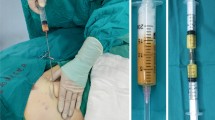Abstract
Background
Despite civilization and progress, burns occur frequently in the world. Remarkable discoveries of wound healing mechanisms have been reported. On the other hand, long-term outcomes from burn injuries represent a barrier to improvement of patients’ social, functional, and psychological condition. Lipofilling, described since the 1980s, currently is used for several clinical applications. This study aimed to verify whether lipofilling could ameliorate scar remodeling in three clinical cases.
Methods
Three adult patients with hemifacial hypertrophic scars and keloids resulting from severe burns 2 to 13 years previously were selected. The patients were treated by injection of adipose tissue harvested from abdominal subcutaneous fat and processed according to Coleman’s technique. Two injections (with a 13-month interval between) were administered at the dermohypodermal junction. Histologic examination of scar tissue punch biopsies (hematoxylin-eosin staining) before and after the treatment was performed as well as magnetic resonance scan with contrast.
Results
The clinical appearance and subjective patient feelings after a 6-month follow-up period suggest considerable improvement in the mimic features, skin texture, and thickness. Histologic examination shows patterns of new collagen deposition, local hypervascularity, and dermal hyperplasia in the context of new tissue, with high correspondence to the original.
Conclusions
The preliminary results show that lipofilling improves scar quality and suggest a tissue regeneration enhancing process.








Similar content being viewed by others
References
Alster CS, Williams CM (1995) Treatment of keloid sternotomy scars by the 585-nm flashlamp-pumped pulsed-dye laser. Lancet 345:1198–1200
Billings E Jr, May JW Jr (1989) Historical review and present status of free fat graft autotransplantation in plastic and reconstructive surgery. Plast Reconstr Surg 83:368–381
Boyadjiev C, Popchristova E, Mazgalova J (1995) Histomorphologic changes in keloids treated with Kenacort. J Trauma 38:299–302
Carney SA, Cason CG, Gowar JP, Stevenson JH, McNee J, Groves AR, Thomas SS, Hart NB, Auclair P (1995) Cica-Care gel sheeting in the management of hypertrophic scarring. Burns 20:163–167
Carr-Collins JA (1992) Pressure techniques for the prevention of hypertrophic scar. Clin Plast Surg 19:733–743
Coleman SR (1997) Facial recontouring with lipostructure. Clin Plast Surg 24:347–367
Coleman SR (1995) Long-term survival of fat transplants: Controlled demonstrations. Aesth Plast Surg 19:421–425
De Ugarte DA, Ashjian PH, Elbarbary A, Hedrick MH (2003) Future of fat as raw material for tissue regeneration. Ann Plast Surg 50:215–219
Ellenbogen R (2000) Fat transfer: Current use in practice. Clin Plast Surg 27:545–556
Ersek RA (1991) Tranplantation of purified autologous fat: A 3-year follow-up is disappointing. Plast Reconstr Surg 87:219–227
Gibran NS, Heimbach DM (2000) Current status of burn wound pathophysiology. Clin Plast Surg 27:11–22
Harrop AR, Ghahary A, Scott PG, Forsyth N, Uji-Friedland A, Tredget EE (1995) Regulation of collagen synthesis and mRNA expression in normal and hypertrophic scar fibroblasts in vitro by interferon-gamma. J Surg Res 58:471–477
Horl HW, Feller AM, Biemer E 1991 Technique for liposuction fat reimplantation and long-term volume evaluation by magnetic resonance imaging. Ann Plast Surg 26:248–258
Kesselring UK (1983) Regional fat aspiration for body contouring. Plast Reconstr Surg 72:610–619
Illouz YG (1983) Body contouring by lipolysis: A 5-year experience with over 3,000 cases. Plast Reconstr Surg 72:591–597
Illouz YG (1988) Present results of fat injection. Aesth Plast Surg 12:175–181
Lawrence WT (1991) In search of the optimal treatment of keloids: Report of a series and review of the literature. Ann Plast Surg 27:164–178
Mojallal A, Foyatier JL (2004) Historical review of the use of adipose tissue transfer in plastic and reconstructive surgery. Ann Chir Plast Esthét 49:419–425
Neuber GA (1893) Fettransplantation. Langenbecks Arch Klin Chir Ver Dtsch Z Chir 22:66
Norris JE (1995) Superficial x-ray therapy in keloid management: A retrospective study of 24 cases and literature review. Plast Reconstr Surg 95:1051–1055
Rigotti G, Marchi A, Galie M, Baroni G, Benati D, Krampera M, Pasini A, Sbarbati A (2007) Clinical treatment of radiotherapy tissue damage by lipoaspirate transplant: A healing process mediated by adipose-derived adult stem cells. Plast Reconstr Surg 119:1409–1422
Tholpady SS, Llull R, Ogle RC, Rubin JP, Futrell JW, Katz AJ (2006) Adipose tissue: Stem cells and beyond. Clin Plast Surg 33:55–62
Von Heimburg D, Pallua N (2001) Two-year histological outcome of facial lipofilling. Ann Plast Surg 46:644–646
Von Heimburg D, Hemmrich K, Haydarlioglu S, Staiger H, Pallua N (2004) Comparison of viable cell yield from excised versus aspirated adipose tissue. Cells Tissues Organs 178:87–92
Yowler CJ, Fratianne RB (2000) Current status of burn resuscitation. Clin Plast Surg 27:1–10
Zuk PA, Zhu M, Mizuno H, Huang J, Futrell JW, Katz AJ, Benhaim P, Lorenz HP, Hedrick MH (2001) Multilineage cells from human adipose tissue: Implications for cell-based therapies. Tissue Eng 7:211–228
Zuk PA, Zhu M, Ashjian P, De Ugarte DA, Huang JI, Mizuno H, Alfonso ZC, Fraser JK, Benhaim P, Hedrick MH (2002) Human adipose tissue is a source of multipotent stem cells. Mol Biol Cell 13:4279–4295
Brzoska M, Geiger H, Gauer S, Baer P (2005) Epithelial differentiation of human adipose tissue-derived adult stem cells. Biochem Biophys Res Comm 330:142–150
Acknowledgments
We thank Daniel Levi, Paolo Gaetani, Luca Di Tommaso, and Silvio Veronese for their significant contribution to our research.
Author information
Authors and Affiliations
Corresponding author
Rights and permissions
About this article
Cite this article
Klinger, M., Marazzi, M., Vigo, D. et al. Fat Injection for Cases of Severe Burn Outcomes: A New Perspective of Scar Remodeling and Reduction. Aesth Plast Surg 32, 465–469 (2008). https://doi.org/10.1007/s00266-008-9122-1
Published:
Issue Date:
DOI: https://doi.org/10.1007/s00266-008-9122-1




